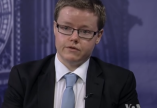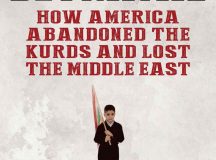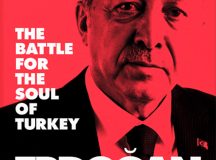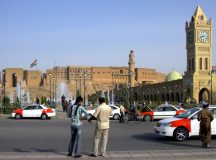The disastrous foreign policies of two presidents are bringing about the collapse of America’s position in the Middle East, argues Kyle Orton.
October 2019 may well remain in the popular memory as the inflection point marking the collapse of America’s — and by extension, the West’s — position in at least the northern Middle East. Having been thwarted twice before in efforts to leave Syria, in March and December 2018, President Donald Trump made one more try. For many, ‘Trump betrayed the Kurds’ will be the summary of the events that followed as Turkey made a swift move into the vacuum. The reality is a lot more complicated, and in truth the amount of blame that Trump can take for the events of the last month is rather limited. This catastrophe was baked into the policy of Barack Obama, and Trump’s main fault is to have followed the policy track laid down by his predecessor.
A Flawed Partnership
The origins of the current mess in northern Syria can be traced to the US having selected the Democratic Union Party (PYD) and its armed division, the People’s Protection Units (YPG), as its Syrian partner force against the Islamic State (ISIS). This alliance began in an ad hoc manner when a town the YPG held, Kobani, was besieged shortly after the US anti-ISIS intervention in Syria began in 2014 and the US airstrikes broke the siege. The US then chose to continue the partnership, enabling an expansion of the YPG-held areas, justified as a pragmatic choice since the YPG was the only available force on the ground. This was untrue.
There were rebel groups available, who had already fought ISIS successfully and had greater legitimacy in the largely Arab areas ISIS had occupied. But these groups were also fighting Bashar al-Asad’s regime. Obama was negotiating a nuclear deal with Iran and a tacit condition was that America would do nothing to threaten Asad’s survival, Tehran’s paramount interest in the region. Obama would wage a narrow ‘counter-terrorism’ war in Syria against ISIS, telling the public this was to avoid being ensnared in the messy underlying war and in private telling the Iranians this was an excellent opportunity for collaboration since the operation aligned with their interests. It was within this Iran-friendly framework that Obama chose the YPG, because of its history of good relations with the pro-Asad coalition.
The PYD/YPG is the name used by the Kurdistan Workers’ Party (PKK) when it operates on Syrian soil. And the PKK, a political extremist outfit that the US itself labels as a terrorist organisation, has waged a decades-long secessionist war in Turkey.
Formed in 1978, the PKK’s ideology mixed Marxism-Leninism and Kurdish nationalism. The group was expelled from Turkey by the coup in 1980 and took shelter in Syria. What was initially a small, cult-like organisation was built into a larger cult-like organisation in the Palestinian terrorist camps of Bekaa valley in Lebanon. The Bekaa was occupied by the Syrian regime, run at that time by Hafez al-Asad, Bashar’s father. And Hafez was acting, as he so often did, at the behest of the Soviet Union as an intermediary to terrorists. The PKK also established relations with Saddam Hussein and the clerical regime in Iran.
Drawing on these external support systems, the PKK insurgency continued through the 1980s and, after a horrific escalation in the early 1990s, with atrocities on all sides, Turkey turned the tide in the mid-1990s. By 1998, Turkey was able to threaten an invasion of Syria if the regime did not cease harbouring terrorists. Asad Sr., who was clearing the decks to allow a smooth transition to his son, acceded, expelling the PKK leader, Abdullah Ocalan and, in public, the rest of the PKK. The eviction was far from total, however.
After the onset of the War on Terror, the PKK sought to rebrand to avoid the terrorism label, creating a ‘confederal model’ that ostensibly devolved authority to groups in each of the four states with significant Kurdish-majority areas — Turkey, Syria, Iraq, and Iran. The PYD was proclaimed in Syria in 2003, having been put together by Osman Ocalan, the brother of Abdullah, at the PKK headquarters in the Qandil Mountains of northern Iraq. The PKK remnants inside Syria simply rebranded as PYD.
Over the next decade, Asad intermittently cracked down on the PYD, as he did with ISIS in the same period, but just as ISIS was allowed to retain essential sanctuary and resources in Syria for its operations in Iraq, the PKK’s core activities continued uninhibited under the close watch of Asad’s secret police.
The PKK began the confederalism experiment in northern Iraq with the Kurdistan Democratic Solution Party (PCDK) in 2002, and in 2004 established the Kurdistan Free Life Party (PJAK) in Iran. What is important to understand is that the PYD, PJAK, and PCDK are not separate from the PKK — not even as distant as Al-Qaeda ‘central’ is with its ‘affiliates’ — but are instead integrated, organic components of a single, transnational structure. Even on paper, these three formations are under the direct, unitary command of the Kurdistan Communities’ Union (KCK) that is headed by Ocalan.
The expansion of the PYD/YPG as it has taken control of territory in Syria and recruited locally has not weakened this structure. The people in control of the ‘Rojava’ area that the PYD/YPG rules over are entirely ‘Qandilians’, veteran PKK operatives trained over decades at the PKK’s headquarters in the Qandil Mountains of northern Iraq, many of them Turkish or Iranian citizens. Only in the lowest rungs of the YPG infantry and the PYD-run civil administration bodies are locally-recruited Kurds a majority, and even these people have been vigorously vetted and indoctrinated. They are also shadowed by PKK military commanders, who ensure ideological and command unity.
The ‘Syrian Democratic Forces’ (SDF), a piece of US marketing to circumvent its own anti-terrorism laws and to try to reduce the political cost of supporting the PKK, was created in October 2015. The SDF theoretically adds Arab, Turkoman, Christian, and other units to a core of YPG cadres. Nobody denies the YPG/PKK is the dominant force in the SDF and many of the non-YPG groups are outright PKK proxies. The few legitimately independent Arab factions that joined the SDF were swiftly marginalised. The exaggerated claims about the Arab proportion of the SDF and the fact that so many Arab SDF units are loyal to Asad’s Ba’thi regime are a sideshow. Ethnic diversity in the SDF was never allowed to interfere with the PKK’s political-military monopoly on power.
The US at times made half-hearted efforts to dilute the power of the PKK in the SDF-held territories but it came to naught. All new recruits, Arab and Kurd, were subjected to indoctrination. A whole separate shell structure was created in the Arab-majority areas to give the appearance of Arab tribes participating in their own governance, while holding no actual power to decide even basic administrative matters and being regarded with barely-hidden contempt by the PKK cadres that run the show.
The democratic utopia the SDF/PKK has set up according to the Western press coverage is a delusion. The reality is a deeply authoritarian one-party system that has systematically destroyed the Kurdish opposition through intimidation, torture, expulsion, and assassination. A new crackdown is ongoing at the present. Recent reports that the Kurdish opposition might be allowed to return to Rojava are a reflection only of the PKK’s need for political goodwill in the West. The PKK has never shared power and will not start now. In the Arab-majority areas, the American effort to dilute PKK hegemony within the SDF by adding more locals to the YPG core was subverted. The PKK simply used the Arabs as more acceptable local administrators for a statelet that remained wholly under its control.
The creation of this PKK statelet on Turkey’s border was an inevitable side-effect of the anti-ISIS war Obama chose to run and Trump chose to continue. The Turkish perception that this was an existential threat to Turkey is not reducible to the abrasive character of Turkish president Recep Tayyip Erdogan. As can be seen by the near-unanimous support across the political spectrum in Turkey for the incursion into Syria against the PKK that began last month, no Turkish government of any character would have treated this issue any differently.
An Inevitable Incursion
That the harvest before us is the result of policies initiated by Obama does not exculpate Trump of his own part in this. Absent a serious push for a Turkey-PKK peace agreement that allowed the US to keep both its ally and its partner, the only conceivable alternatives were a withdrawal that amounted to siding with Turkey by allowing the dismantling of Rojava, or remaining in defence of the PKK statelet that would rupture relations with Turkey over the long term. There was no necessity in these options for the way Trump has behaved, making this so chaotic and humiliating.
Trump made a statement on 6 October that it was ‘time for us to get out’ and let others ‘figure the situation out’. Three days later, Turkey launched a third operation into Syria, codenamed BARIS PINARI (PEACE SPRING), into the PKK-held area east of the Euphrates River evacuated by the Americans.
Since Turkey wishes to keep its casualties down for domestic political reasons, the operation is fronted by Syrian Arab proxies. The Arab militias Turkey is working with are the remnants of an armed rebellion against Asad that was defeated with the most cruel and indiscriminate methods seen in this century. The people still on the battlefield after this are the desperate and the brutal, the people who have no other choice and the people who were, or have become, coarse enough to survive and in some ways thrive in an environment of this kind. The abuses that have followed were predictable.
The misbehaviour of Turkey’s proxies has been weaved skilfully into a PKK information operation the scale and effectiveness of which is a true marvel. The PKK got lucky in one respect: since Trump had green-lit the Turkish incursion, it became an issue in America’s politics, and the Left-leaning American mass media sought to portray it in the worst possible light. But even so, the number of Western journalists that it turned out were willing to print, without scepticism or qualification, the messaging of a terrorist movement was, as with and the devotion of bureaucrats at the Pentagon to the PKK, truly stunning.
Under pressure from this echo chamber between the PKK, the bureaucracy, and the media — soon with additional criticism from within his own Republican Party — Trump reversed himself. A week into BARIS PINARI, tweets were sent by Trump threatening to ‘swiftly destroy Turkey’s economy if Turkish leaders continue down this dangerous and destructive path’, a path that, again, he had signed-off on. A surreal letter Trump had sent to Erdogan on the eve of the incursion was then released. Days later, on 17 October, Turkey signed a ceasefire agreement with America, giving Ankara essentially everything it asked for: a PKK-free buffer zone along the border and the lifting of the announced sanctions over the incursion.
Trump settled on a new plan for American troops to stay in Syria, but only in a smaller zone further south, away from Turkey’s border, to guard the oil. This would involve the PKK, which was preparing to fold itself back into the Asad regime through Russian mediation, instead sticking with America. Why the PKK should want to do this, given that America will soon depart and has proven unwilling even while present to protect it against Turkey, is less clear, though for now it is apparently the course the PKK is taking.
Trump’s stated goal was to keep the oil out of the hands of ISIS. The problems with this were numerous, starting with Syria not having much oil, these oil facilities being largely destroyed, and the PKK gaining revenue from the oil it did withdraw by sending it to the Asad/Iran system, funding a killing machine in violation of American sanctions (though the Pentagon soon announced it was fine with this).
The ‘war/blood for oil’ mantra has been used about the Iraq invasion since before it began in 2003, and here is Trump apparently confirming the worst that is said of America. The situation, however, is even worse than that. Trump was sold the ‘Oil Region’ idea on the basis of his repeated statements that America should have kept Iraq’s oil, but this is a way for the bureaucracy to get the President to agree to keep troops in Syria, while they try to run their own, more expansive policy—for the Pentagon/CENTCOM against ISIS, for some in the White House and State Department against Iran. ‘This is like feeding a baby its medicine in yogurt or applesauce, as one official told The Washington Post.
The end result of this whirlwind — where Trump managed to damage relations with the PKK and Turkey — was summarised by a New York Times headline at the end of October, ‘Hundreds of US Troops Leaving, and Also Arriving in, Syria’. The roughly 1,000 troops ordered to pull out of north-eastern Syria were heading into Iraq as the less-than-1,000 troops needed to staff this ‘Oil Region’ came into Syria from Iraq. At the time of writing, the plan is to leave no more than 600 troops around the oil wells in eastern Syria, plus 150 troops at the Tanf base in southern Syria near the Jordanian border.
‘The footprint will be small, but the objective will remain the same [italics added],’ said Gen. Mark Milley, the US chairman of the Joint Chiefs of Staff, apparently in complete disregard of the President, who has terminated this mission three times and will probably do so again once he finds out what is going on.
Trump’s Regional Policy
Trying to predict the future with Trump is near-impossible, yet his record after nearly three years is clear. Trump’s break with Obama was most emphatic over Iran. Trump’s rhetoric no longer spoke of Iran becoming a ‘very successful regional power’. The traditional words of enmity were restored, as were the sanctions, with Trump announcing a ‘maximum pressure’ campaign and pulling the US out of the nuclear deal, the Joint Comprehensive Plan of Action (JCPOA). Trump’s first trip abroad was to Saudi Arabia, a country that had, like the US’s other major regional allies in Israel and Turkey, become severely alienated by the Obama policies that favoured Iran. But there was less to this than met the eye.
The biggest decision on Trump’s desk when he came into office was how to liberate ISIS’s Syrian ‘capital’, Raqqa. Having reacted to Asad’s use of chemical weapons with missile strikes in April 2017, fulfilling the ‘red line’ promise Obama shrank from, the stage was set when Trump arrived in Riyadh to leverage the Turkish offer of troops to secure Saudi and Gulf buy-in for a Sunni force to put an end to the caliphate. This would be far more effective in doing ideological damage to ISIS and would have left anti-Iran US allies holding key parts of Syria, able to force a settlement more in line with Western interests.
Instead, nothing concrete emerged from the Saudi meeting and, after some initial hesitation, Trump opted to follow the plan Obama left to him of using the PKK — the partners selected precisely because they were congruent with Obama’s pro-Iran tilt — to clear Raqqa. In so doing, he locked in the Iran-friendly regional policy set by his predecessor.
When Obama tried to use the threat of ending support to the Syrian rebels to pressure Saudi Arabia in 2013, a senior official had remarked, ‘Okay, stop it. It’s not doing anything anyway.’ Obama chose to keep the rebel support program formally alive. In mid-2017, Trump cut off US support to the rebellion, confirming that Asad was safe, a mortal blow to any anti-Iran policy. Asad’s downfall would be, as former Secretary of Defense James Mattis once put it, ‘the biggest strategic setback for Iran’ since the Iran-Iraq war. In effect, Trump followed Obama’s policy, just without the façade.
In October 2017, Qassem Sulaymani, the head of Iran’s Quds Force, the foreign wing of its Islamic Revolutionary Guards Corps (IRGC), orchestrated an offensive in Iraq that evicted the pro-Western Kurdistan Democratic Party (KDP) from Kirkuk and the US did nothing. There was a good case against the KDP being in Kirkuk, which it had taken under the cover of the anti-ISIS war in 2014. But this could have been settled by negotiation. Of the few taboos that remained in post-Saddam Iraq, one was that political differences are not settled by violence; this, too, has now been shattered, creating an environment much more amenable to Iran, as has been on display over the last few weeks.
Then came the fall of Deraa in southern Syria in the summer of 2018. In this area, on the border with Israel, Trump had arranged a ceasefire with the Russians and the Israeli government had supported some rebel groups to provide a buffer against ISIS and Iran’s Shi’a jihadists. In exchange for some flagrantly insincere Russian promises to keep the Iranians at a safe distance, the Americans and Israelis stood aside as the pro-Asad coalition reconquered Deraa. Almost immediately, Israel started uncovering IRGC/Hizballah cells infiltrating across its border, and in any future confrontation the Jewish state will now face a two-front war with Hizballah, from Lebanon and Syria. The mere threat of forcible retaliation from the Americans against the pro-Asad coalition could have avoided this. That Trump would not expend so little to defend so much should have been the end of the illusions that a serious anti-Iran policy existed.
The final end of all doubt about Trump’s lack of an effective anti-Iran strategy came in September 2019. Iran launched ballistic missiles from its own territory against the oil installations of ARAMCO in Saudi Arabia, an audacious act targeting the lifeblood of the entire American-underwritten international order, and Trump allowed it to pass without retaliation, except perhaps for a cyber-attack that the Iranians don’t seem to have noticed. Three months earlier, after a spate of Iranian piracy, Tehran shot down a US drone — and Trump would not give the order to inflict a military price on Iran. The message reached US allies, including those like the United Arab Emirates and Saudi Arabia that are ostensibly the most hawkish on Iran, and they are now moving to make terms with the Islamic Republic.
The ‘maximum pressure’ campaign can now be said to have failed. Its fatal weaknesses were its myopic focus on the nuclear deal and the lack of a kinetic component to push Iran back where it matters, on the ground in the region. Trump’s promise to his base to avoid entanglements in the Middle East — and there is an election approaching, after all — meant he would never pull the trigger. Sanctions are the only tool Trump has licensed, and the effect of financial pressure is limited on revolutionary regimes. Those who had hopes he would chart a better course also misread what he really wanted. He has made clear time and again that what he wants is a new deal with Iran that he can present as better than Obama’s. The result has been a split in the Western coalition, as the Europeans cling to JCPOA and the US threatens to catch them in secondary sanctions, and debates over the minutiae of a new nuclear accord — while Iran’s imperial rampage goes unchecked.
Obama came into office promising to end America’s involvement in the wars in the Middle East. To do this, he would replace American hegemony with an ‘equilibrium’ between America’s traditional allies and the Iranian theocracy. Obama’s device for doing this was the nuclear deal. By definition, this meant empowering Iran, since the regime had heretofore been contained. Iran would now have ‘equities’ that needed to be respected in area after area, most importantly in Syria, where Iran regarded the Asad regime’s survival as an existential issue. When Obama was forced to wage the anti-ISIS campaign, he did so in conformity with Tehran’s designs, choosing partners in the PKK that did not threaten Iran’s core interests in Syria. This framework — which would have taken considerable energy and attentional to break out of — has been adopted by Trump in all its essentials. Even on the nuclear file, where Trump has so ostentatiously broken with his predecessor, there is great continuity: Trump would be satisfied with a few tweaks he could call improvements over Obama’s accord. The style in which Trump’s Middle East policy has failed is his own, but the substance is significantly Obama’s.






































Trump didn’t lose the American position in the Middle East. He is actually in full control. Obama, who planted blood shed throughout the Middl East, lost.
“Rebel groups available” alternative to YPG is the statement I’m not agree with. The US tried to equip and training a force in Turkey, with disastrous results.
If this “alternative groups” availability was an idea of David Cameron..I’m shure it was a bad idea !
YPG is the most democratic group you can find in Syria, amid Jihadist groups.
The West ( with Israel) should support a strong lay Kurdistan against Turkey and the other islamist countries of the region.